AscentXmedia
Dividend investing is a compelling way to compound wealth over the long term for several reasons:
- It provides a consistent and often growing income stream, which can be particularly valuable in periods of market volatility or during an economic downturn.
- Dividend-paying stocks typically belong to financially strong companies with a history of stable earnings, lending a degree of safety and predictability to investments.
- It provides visible evidence of the power of compounding, especially when dividends are reinvested, leading to exponential portfolio value and passive income growth over time.
- Dividend investing encourages investors to keep a long-term perspective by focusing on the passive income stream instead of the ever-changing quoted value of their portfolio, helping investors avoid the pitfalls of trying to time the market and fostering a disciplined and patient approach to wealth building.
As a result, dividend ETFs appreciate the Schwab U.S. Dividend Equity ETF (NYSEARCA:SCHD) and the JPMorgan Equity Premium Income ETF (NYSEARCA:JEPI) are popular funds among investors, as evidenced by their rapid growth in assets under management over the course of their lives:
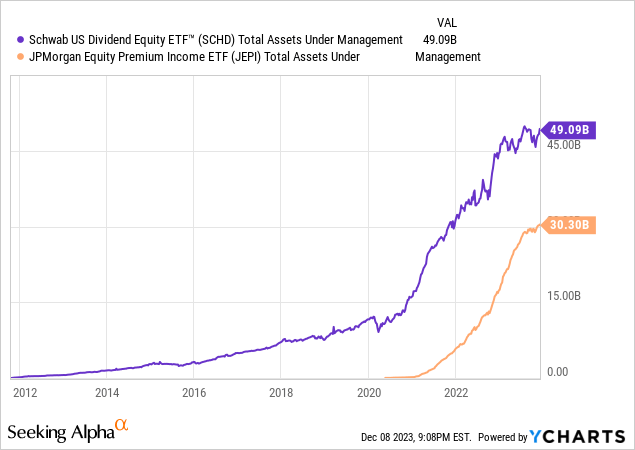
In this article, we differentiate them side by side and offer our take on which one is the better buy in the current macro environment.
The Current Macro Environment
As we head towards the end of 2023 and begin looking towards 2024, the dominant macroeconomic stories are a refuse in inflation, slowing economic activity, expectations of future interest rate cuts, simmering geopolitical tensions around the world, and fairly bloated valuations in major indexes such as the S&P 500 (SPY) and Nasdaq (QQQ).
The U.S. inflation rate has been in steady refuse and annualizing data over the past several months indicates that the inflation rate is nearing the Fed’s target rate. Meanwhile, there are numerous signs that the U.S. economy is cooling, though the extent of this is debated and many are still holding out hope for a soft landing. Estimates of a recession in the U.S. vary from 35% to 65% at the moment. Given the cooling inflation and economic activity, the Federal Reserve is increasingly expected to cut interest rates in the first half of 2024, with predictions ranging from as early as March to later in the year.
Simmering geopolitical tensions add encourage to the complexity of the economic landscape. The Russia-Ukraine conflict continues to impact global trade and commodity markets while growing U.S.-China tensions threaten to throw a major wrench into the global economy should a conflict erupt over Taiwan. The Middle East also remains highly volatile, and an expansion of the current conflict in Gaza to include major oil producers appreciate Iran and/or Saudi Arabia could provoke energy prices to spike.
Against this backdrop of uncertainty and potential recession, major market indexes look overvalued relative to historical norms according to leading valuation models such as the Buffett Indicator, the Price/Earnings Ratio Model, and the S&P 500 Mean Reversion Model. With that in mind, is SCHD or JEPI a better way to invest for dividends in December 2023?
SCHD Stock vs JEPI Stock: Total Return Track Record
As the chart below illustrates, SCHD has meaningfully outperformed JEPI since JEPI went public:
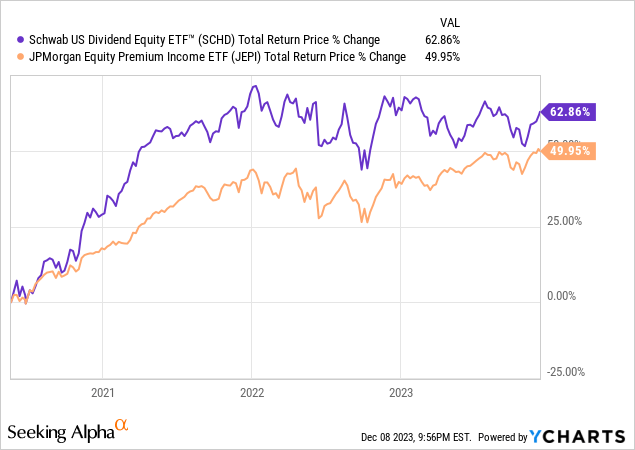
Moreover, SCHD has delivered respectable long-term total return performance relative to the S&P 500 (SPY) and in fact has outperformed it slightly until the huge artificial intelligence boom of 2023 lifted the mega-cap rich SPY higher while the higher for longer interest rate narrative weighed heavily on the dividend stocks in SCHD’s portfolio:
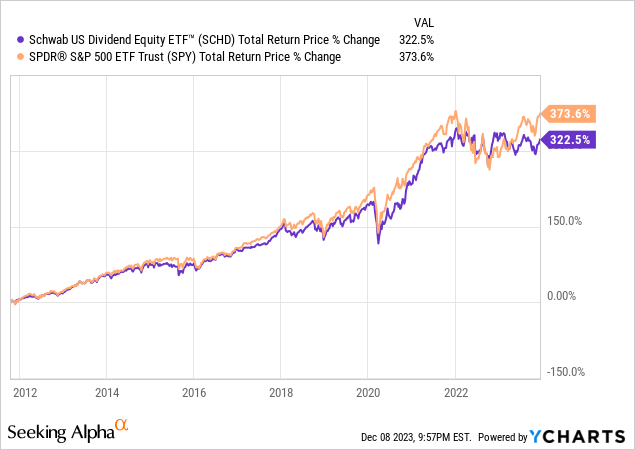
Moreover, SCHD’s expense ratio is quite low at just 0.06%, whereas JEPI’s is almost six times higher at 0.35%. As a result, we can deduce that SCHD is a proven long-term wealth compounder for investors that can be expected to deliver total returns that roughly match SPY’s over the long term while also providing the aforementioned benefits of dividend growth investing.
Meanwhile, JEPI’s total return performance is too short to be able to evaluate it sufficiently in that regard, though its significantly higher expense ratio will furnish it with a meaningful headwind relative to SCHD to deal with over the long term.
SCHD Stock Vs. JEPI Stock: Dividend Growth Track Record
When it comes to dividend growth, SCHD is a top-notch dividend grower, posting an 11.39% CAGR. In contrast, JEPI’s dividend payouts have been erratic with little to no evidence of having an underlying growth trend:
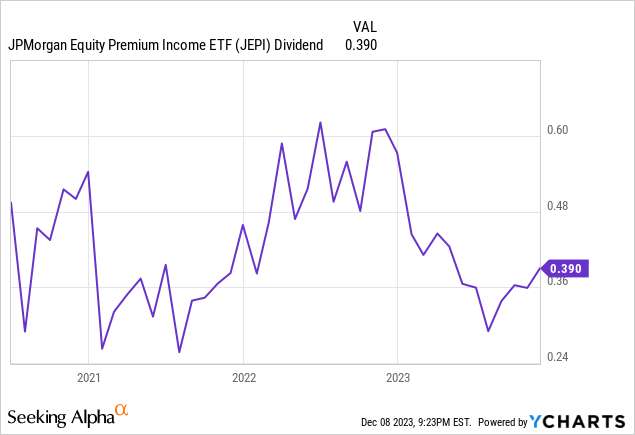
The reason for this discrepancy is that SCHD explicitly focuses its portfolio on dividend growth stocks and holds them in a relatively passive manner within its portfolio for the long term. In contrast, JEPI generates the vast majority of its dividends from the premiums that it generates off of implementing its covered call strategy. As a result, its cash flow can tend to be a bit lumpy from month to month depending on the implied volatility at the time. As a result, for investors looking for stable income and predictable dividend growth, SCHD is a much more attractive option.
SCHD Stock Vs. JEPI Stock: Dividend Yield
While SCHD may be the undisputed winner in terms of dividend stability and growth, JEPI makes up for its deficiencies with its superior dividend yield.
Over the past twelve months, JEPI has delivered an 8.74% dividend yield to its shareholders while SCHD has delivered a mere 3.67% dividend yield to its shareholders. As the table below illustrates, while dividend growth is certainly a powerful tool for long term income and total return compounding, it takes a lot of dividend growth over an extended period of time to catch up to a much higher current yield:
| Starting Dividend Yield | 10-Year CAGR to achieve a 7% Yield on Cost |
| 1% | 21.48% |
| 1.5% | 16.65% |
| 2% | 13.35% |
| 2.5% | 10.84% |
| 3% | 8.84% |
| 3.5% | 7.18% |
| 4% | 5.76% |
| 4.5% | 4.52% |
| 5% | 3.42% |
| 5.5% | 2.44% |
| 6% | 1.55% |
As a result, investors who prioritize current yield over long-term dividend growth would likely greatly prefer JEPI over SCHD. As an aside, JEPI also pays its dividends monthly whereas SCHD pays its dividends quarterly, encourage accentuating its strength as a current income investment relative to SCHD.
SCHD Stock Vs. JEPI Stock: Portfolio Composition
Last, but not least, when comparing their portfolios, the most notable contrast between JEPI and SCHD is in their sector exposures. JEPI has a higher allocation to technology at 18.26% (its largest sector, in fact) and lower exposure to energy and industrials compared to SCHD, whose largest sector exposure is to industrials. This makes SCHD’s recent outperformance of JEPI quite remarkable given that technology (QQQ) has significantly outperformed over the course of JEPI’s existence:
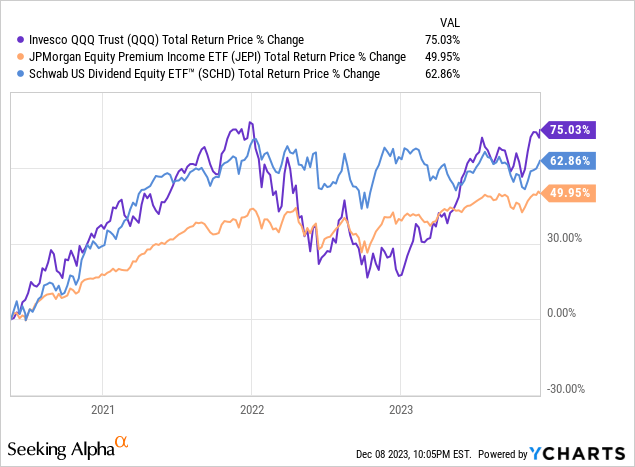
Another observation is that JEPI’s portfolio includes 137 holdings, slightly outdoing SCHD’s 104 holdings. The top 10 holdings of JEPI, featuring Microsoft Corp (MSFT), Amazon.com Inc (AMZN), and Adobe Inc (ADBE), among others, comprise just 15.65% of its portfolio, showing that its portfolio is very well diversified across each of its holdings and greatly reducing individual stock risk. In contrast, SCHD has a whopping 40.39% of its portfolio allocated to its top ten holdings, with Verizon Communications Inc (VZ), Amgen Inc (AMGN), and Broadcom Inc (AVGO) serving as its top three positions.
Investor Takeaway
While both JEPI and SCHD offer distinct advantages for dividend-focused investors, they ultimately cater to different aspects of the dividend investing strategy. JEPI stands out as the preferable option for those prioritizing immediate income, offering a higher dividend yield that appeals to retirees or investors who necessitate current monthly cash flow. On the other hand, SCHD shines as the superior choice for long-term total return and dividend growth, appealing to those with a longer investment horizon aiming to build wealth through compounding dividends and capital appreciation over years or even decades. An optimal investment strategy for retirees, therefore, might involve allocating assets to both JEPI and SCHD, striking a balance that aligns with individual income needs and growth objectives.
Given the fact that mega-cap tech appears to be richly valued at the moment whereas dividends and value appear to be a bit beaten down – at least on a relative basis – as well as the fact that the more defensive positioning of SCHD’s portfolio may help it weather an economic downturn better than JEPI’s holdings will, we think that SCHD may be the better value at the moment. Moreover, when taking into account our assessment of total returns, expense ratios, and dividend growth track records, SCHD emerges as the superior ETF overall, but a strategic allocation of assets between the two may enhance for some investors the balance between current yield and long-term growth prospects.



